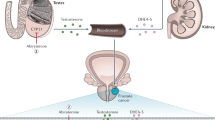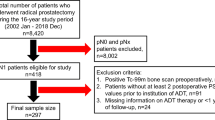Abstract
Background:
Radical prostatectomy (RP) has limited cancer control potential for the patient with high-risk prostate cancer (Pca). We prospectively examined the efficacy and safety of neoadjuvant therapy with luteinizing hormone-releasing hormone (LHRH) agonist + low-dose estramustine phosphate (EMP) (LHRH+EMP) followed by RP.
Methods:
High-risk Pca was defined by the D’Amico stratification system. A total of 142 patients with high-risk Pca were enrolled in this trial from September 2005 to March 2011. The LHRH+EMP therapy included administration of LHRH agonist and 280 mg day–1 EMP for 6 months before RP. Pathological cancer-free (pT0) rate on the surgical specimen was the primary end point. Secondary end points were PSA-free survival and toxicity.
Results:
The average patient age was 67.4 years (interquartile range (IQR) 72, 65) and the median initial PSA level was 14.80 ng ml–1 (IQR 26.22, 7.13). The median Gleason score was 9 (IQR 9, 7) and 97 patients (68.3%) had clinical stage T2c or T3. All patients completed 6 months of LHRH+EMP neoadjuvant therapy with no delays in RP. Seven patients (4.9%) achieved pT0. Surgical margins were negative in 125 patients (87.0%). At a median follow-up period of 34.9 months, PSA-free survival was 84.3%. No serious adverse events were reported during the study and there were no toxicity-related deaths.
Conclusions:
Six months of LHRH+EMP neoadjuvant therapy followed by RP is safe and oncological outcomes are acceptable. Although this study was a single-arm trial with a relatively short follow-up, this treatment may have a potential to improve PSA-free survival in high-risk Pca patients. Further clinical trials are warranted.
This is a preview of subscription content, access via your institution
Access options
Subscribe to this journal
Receive 4 print issues and online access
$259.00 per year
only $64.75 per issue
Buy this article
- Purchase on Springer Link
- Instant access to full article PDF
Prices may be subject to local taxes which are calculated during checkout



Similar content being viewed by others
References
D’Amico AV, Whittington R, Malkowics SB, Schultz D, Blank K, Broderick GA et al. Biochemical outcomes after radical prostatectomy, external beam radiation therapy, or interstitial radiation therapy for clinically localized prostate cancer. JAMA 1998; 280: 969–974.
Joniau S, Van Poppel V . Localized prostate cancer: can we better define who is at risk of unfavorable outcome? BJU Int 2008; 101: S5–S10.
Soloway MS, Pareek K, Sharifi R, Wajsman Z, McLeod D, Wood Jr DP et al. Neoadjuvant androgen ablation before radical prostatectomy in cT2bNxM0 prostate cancer: 5-year results. J Urol 2002; 167: 112–116.
Gleave ME, Goldenberg SL, Chin JL, Warner J, Saad F, Klotz LH et al. Randomized comparative study of 3 versus 8-months neoadjuvant hormonal therapy before radical prostatectomy: biochemical and pathological effects. J Urol 2001; 166: 500–507.
Klotz LH, Goldenberg SL, Jewett MA, Fradet Y, Nam R, Barkin J et al. Long-term follow-up of a randomized trial of 0 versus 3 months of neoadjuvant androgen ablation before radical prostatectomy. J Urol 2003; 170: 791–794.
Schulman CC, Debruye FM, Forster G, Selvaggi FP, Zlotta AR, Witjes WP . 4-Year follow-up results of a European prospective randomized study on neoadjuvant hormonal therapy prior to radical prostatectomy in T2-3N0M0 prostate cancer. European Study Group on Neoadjuvant Treatment of Prostate Cancer. Eur Urol 2000; 38: 706–713.
Dreicer R, Magi-Galluzzi C, Zhou M, Rothaermel J, Reuther A, Ulchaker J et al. Phase II trial of neoadjuvant docetaxel before radical prostatectomy for locally advanced prostate cancer. Urology 2004; 63: 1138–1142.
Magi-Galluzzi C, Zhou M, Reuther AM, Dreicer R, Klein EA . Neoadjuvant docetaxel treatment for locally advanced prostate cancer: a clinicopathologic study. Cancer 2007; 110: 1248–1254.
Chi KN, Chin JL, Winquist E, Klotz L, Saad F, Gleave ME . Multicenter phase II study of combined neoadjuvant docetaxel and hormone therapy before radical prostatectomy for patients with high risk localized prostate cancer. J Urol 2008; 180: 565–570.
Prayer-Galetti T, Saccot E, Psgano F, Gardiman M, Cisternino A, Betto G et al. Long-term follow-up of a neoadjuvant chemohormonal taxane-based phase II trial before radical prostatectomy in patients with non-metastatic high-risk prostate cancer. BJU Int 2007; 100: 274–280.
Friedman J, Dunn RL, Wood D, Vaishampayan U, Wu A, Bradley D et al. Neoadjuvant docetaxel and capecitabine in patients with high risk prostate cancer. J Urol 2008; 179: 911–915.
Garzotto M, Higano CS, O’Brien C, Rademacher BL, Janeba N, Fazli L et al. Phase 1/2 study of preoperative docetaxel and mitoxantrone for high-risk prostate cancer. Cancer 2010; 116: 1699–1708.
Eklov S, Nilsson S, Larson A, Björk P, Hartley-Asp B . Evidence for a non-estrogenic cytostatic effects of estramustine on human prostatic carcinoma cells in vivo. Prostate 1992; 20: 43–50.
Speicher LA, Laing N, Barone LR, Robbins JD, Seamon KB, Tew KD . Interaction of an estramustine photoaffinity analogue with cytoskeltal proteins in prostate carcinoma cells. Mol Pharmacol 1994; 46: 866–872.
Hoshi S, Yamaguchi O, Fujioka T, Arai Y, Tomita Y, Habuchi T et al. A randomized comparative study of endocrine monotherapy and a combination of estramustine phosphate with the endocrine therapy in patients with untreated stage D prostate cancer. Int J Clin Oncol 2006; 11: 303–308.
Noguchi M, Noda S, Yoshida M, Ueda S, Shiraishi T, Itoh K . Chemohormonal therapy as primary treatment for metastatic prostate cancer: a randomized study of estramustine phosphate plus luteinizing hormone-releasing hormone agonist versus flutamide plus luteinizing hormone-releasing hormone agonist. Int J Urol 2004; 11: 103–109.
Koie T, Okamoto T, Imanishi K, Sugiyama N, Suzuki Y, Mori K et al. Phase II trial of neoadjuvant LHRH plus estramustine for high risk prostate cancer followed by radical prostatectomy. J Urol 2010; 183 (Suppl 4): e258 (abstract 659).
Koie T, Yamamoto H, Hatakeyama S, Kudoh S, Yoneyama T, Hashimoto Y et al. Minimum incision endoscopic radical prostatectomy: clinical and oncological outcomes at a single institute. Eur J Surg Oncol 2011; 37: 805–810.
Epstein JI, Allsbrook Jr WC, Amin MB, Egevad LL . The 2005 International Society of Urological Pathology (ISUP) consensus conference on Gleason gradibg of prostatic carcinoma. Am J Surg Pathol 2005; 29: 1228–1242.
Greene FL, Page DL, Fleming ID, Fritz A, Balch CM, Haller DG et al. AJCC Cancer Staging Manual, 6th edn Springer-Verlag: New York, 2002.
Gleave M, Kelly WK . High-risk localized prostate cancer: a case for early chemotherapy. J Clin Oncol 2005; 23: 8186–8191.
Vuky J, Porter C, Isacson C, Vaughan M, Kozlowski P, Picozzi V et al. Phase II trial of neoadjuvant docetaxel and gefitinib followed by radical prostatectomy in patients with high-risk, locally advanced prostate cancer. Cancer 2009; 115: 784–791.
Womble PR, VanVeldhuizen PJ, Nisbet AA, Reed GA, Thrasher JB, Holzbeierlein JM . A phase II clinical trial of neoadjuvant ketoconazole and docetaxel chemotherapy before radical prostatectomy in high risk patients. J Urol 2011; 186: 882–887.
Taplin ME, Montgomery RB, Logothetis C, Bubley GJ, Richie JP, Dalkin BL et al. Effect of neoadjuvant abiraterone acetate plus leuprolide acetate on PSA, pathological complete response (pCR), and near pCR in localized high-risk prostate cancer: results of a randomized phase II study. J Clin Oncol 2012; 30 (Suppl) abstract 4521.
Van Poppel H, Werbrouck PW, Baert L . Effect of estramustine phosphate on free androgens: a comparative study of the effect on orchiectomy and estramustine phosphate on free androgens in patients with prostatic cancer. Acta Urol Belg 1990; 58: 89–95.
Lawrentschuk N, Fernandes K, Bell D, Barkin J, Fleshner N . Efficacy of a second line luteinizing hormone-releasing hormone agonist after advanced prostate cancer biochemical recurrence. J Urol 2011; 185: 848–854.
Kraus S, Noar Z, Seger R . Gonodotropin-releasing hormone in apoptosis of prostate cancer cells. Cancer Lett 2006; 234: 109–123.
Limonta P, Dondi D, Moretti RM, Maggi R, Motta M . Antiproliferative effects of luteinizing hormone-releasing hormone agonists on the human prostatic cancer cell line LNCaP. J Clin Endocriol Metab 1992; 75: 207–212.
Pinski J, Reile H, Halmos G, Groot K, Schally AV . Inhibitory effects of analogs of luteinizing hormone-releasing hormone on the growth of the androgen-independent Dunning R-3327-AT-1 rat prostate cancer. Int J Cancer 1994; 59: 51–55.
Janknegt RA, Boon TA, van de Beek C, Grob P . Combined hormono/chemotherapy as primary treatment for metastatic prostate cancer: a randomized, multicenter study of orchiectomy alone versus orchiectomy plus estramustine phosphate. The Dutch Estracyt Study Group. Urology 1997; 49: 411–420.
Fukagai T, Namiki TS, Carlile RG, Yoshida H, Namiki M . Comparison of the clinical outcome after hormonal therapy for prostate cancer between Japanese and Caucasian men. BJU Int 2006; 97: 1190–1193.
Peters N, Armstrong K . Racial differences in prostate cancer treatment outcomes: a systematic review. Cancer Nurs 2005; 28: 108–118.
Author information
Authors and Affiliations
Corresponding author
Ethics declarations
Competing interests
The authors declare no conflict of interest.
Rights and permissions
About this article
Cite this article
Koie, T., Ohyama, C., Yamamoto, H. et al. Safety and effectiveness of neoadjuvant luteinizing hormone-releasing hormone agonist plus low-dose estramustine phosphate in high-risk prostate cancer: a prospective single-arm study. Prostate Cancer Prostatic Dis 15, 397–401 (2012). https://doi.org/10.1038/pcan.2012.29
Received:
Revised:
Accepted:
Published:
Issue Date:
DOI: https://doi.org/10.1038/pcan.2012.29
Keywords
This article is cited by
-
Significance of pelvic lymph node dissection during radical prostatectomy in high-risk prostate cancer patients receiving neoadjuvant chemohormonal therapy
Scientific Reports (2022)
-
Neoadjuvant hormonal therapy before radical prostatectomy in high-risk prostate cancer
Nature Reviews Urology (2021)
-
Neoadjuvant chemohormonal therapy followed by robot-assisted and minimum incision endoscopic radical prostatectomy in patients with high-risk prostate cancer: comparison of perioperative and oncological outcomes at single institution
International Urology and Nephrology (2018)
-
Overall survival of high-risk prostate cancer patients who received neoadjuvant chemohormonal therapy followed by radical prostatectomy at a single institution
International Journal of Clinical Oncology (2017)
-
Cost-effectiveness comparison between neoadjuvant chemohormonal therapy and extended pelvic lymph node dissection in high-risk prostate cancer patients treated with radical prostatectomy: a multi-institutional analysis
Medical Oncology (2017)



